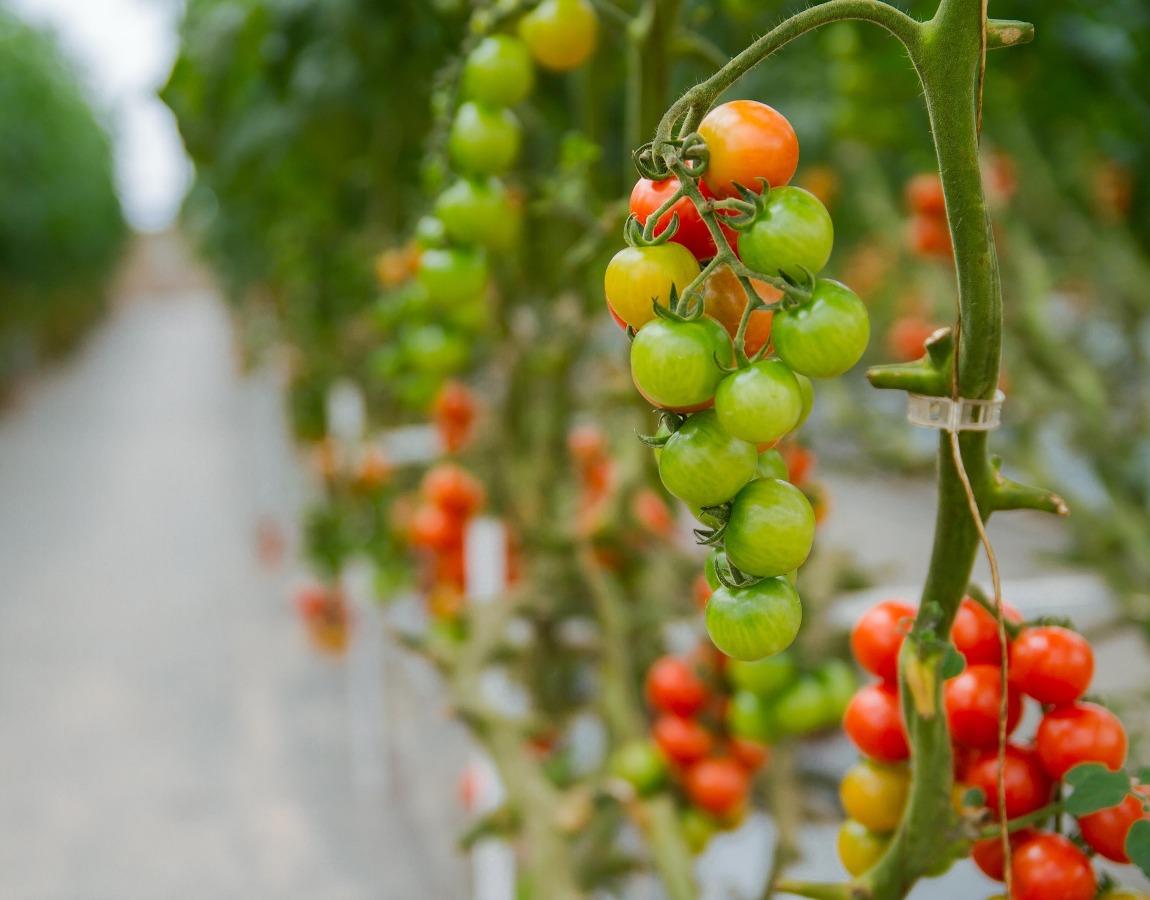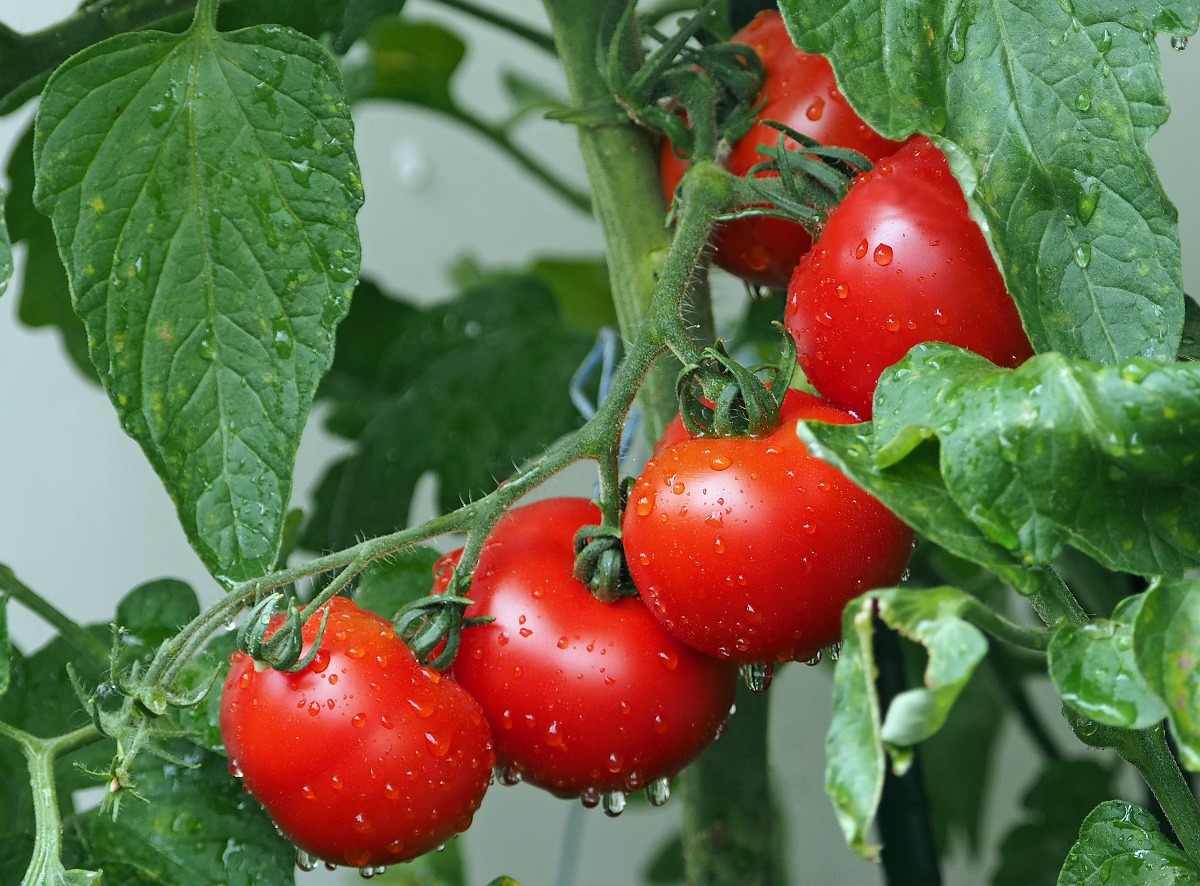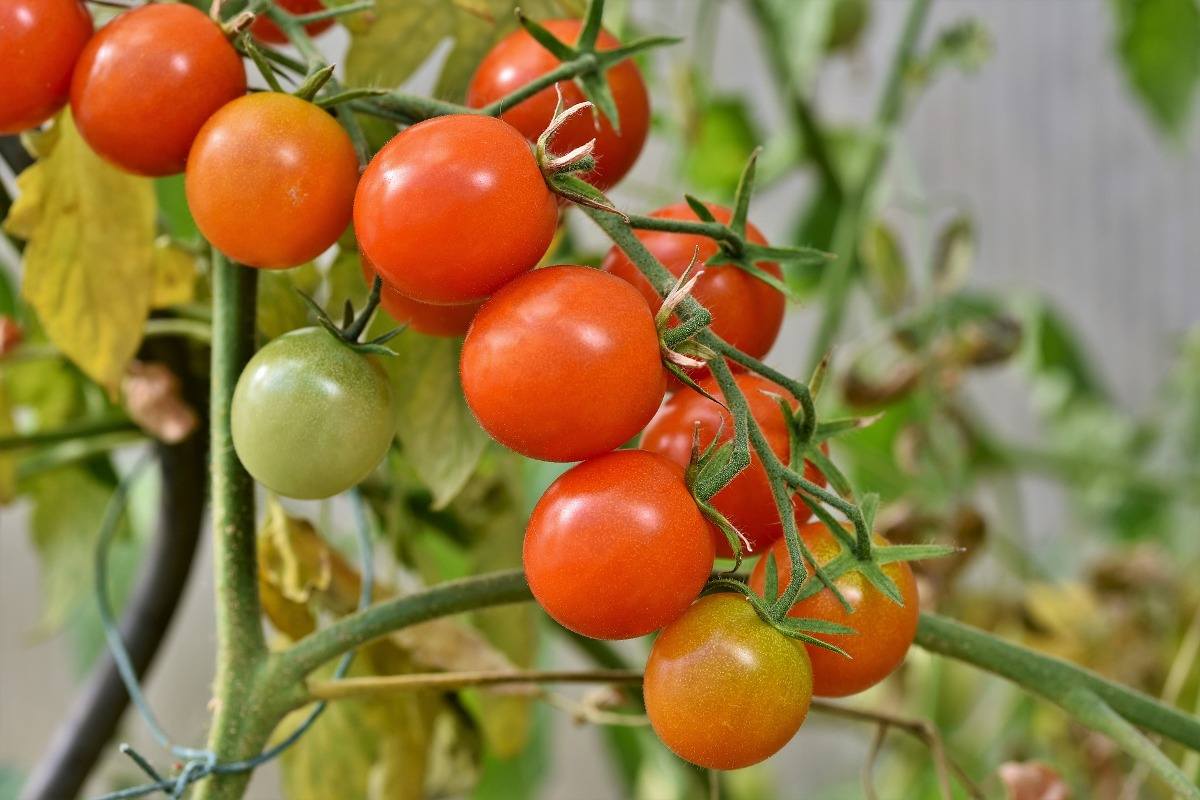Introduction: Hello farmers, we have great information for you about hydroponic tomato farming in India and the complete process of growing hydroponic tomatoes. Hydroponic tomatoes are grown in a nutrient solution rather than soil, while they are placed in a non-soil material that can support their roots. Growing tomatoes hydroponically allows the grower to raise them in a controlled environment with less chance of plant disease, faster plant growth, and greater crop yield.
A step by step guide to hydroponic tomato farming
Growing tomatoes hydroponically, indoors under lights, are equal to, or superior in flavor and nutrition than their outdoor, soil-grown counterparts. A tomato’s sweetness and the flavor is dependent on light and temperature. The nutritional value of a tomato is mainly dependent on the nutrition the plant receives while growing and producing fruit.

In this article we also cover the following topics;
- Hydroponic system types for growing tomatoes
- Optimal pH for tomato growing hydroponically
- Grow hydroponic tomatoes commercially
- Ideal light growing conditions for hydroponic tomatoes
- Hydroponic tomatoes average yield
- Hydroponic tomato nutrient requirements
- Time to take for growing hydroponic tomatoes
- Growing materials for hydroponic tomatoes
A suitable location for growing hydroponic tomatoes
Hydroponics systems are only suitable for indoor environments. They need precise control to function properly, so they should be set up somewhere closed off from other rooms and the outside. This allows you to set the temperature and humidity to accurate levels wanted for the best growth. It is possible to grow hydroponic tomatoes using natural light, but keep the system under glass or polyethylene covering such as a greenhouse roof, not open to the air.
Type of hydroponic system to growing tomatoes
There are different varieties of hydroponic systems, and tomatoes can grow well in any of them. The instructions in this section will teach you how to construct an ebb and flow system, which is relatively cheap and easy to build. This system is known as a flood and drain system because it floods the plants with nutrient solution and then the solution drains when it is about 2 inches from the top of the container.
Tomatoes are hardly enough to work with a wide range of hydroponic techniques. But as they are heavy feeders, the level of maintenance necessary can be a problem for some techniques.
For example, in the fruiting stage, these plants can take massive amounts of potassium and micronutrients. If you are using a recirculating system, the pH can get altered pretty quickly.
Tomatoes can be grown using any of the following hydroponic methods;
- Nutrient Film Technique
- Deep Flow Technique
- Drip System
- Ebb-and-flow
Tomato seeds for a hydroponic system
Several tomato varieties have been particularly developed for hydroponic production in controlled environments. All tomato varieties have indeterminate morphology; meaning vegetative growth of the plant is continual and does not stop once flowering begins. This wants long tomato “vines” which must be trained up strings hanging from the greenhouse structures to maximize space and manage the crop. Some of the more popular tomato varieties are Apollo, Belmondo, Caruso, Dombito, Larma, Perfecto, Trend and Trust. These are hybrid tomato varieties, and the seed can be rather expensive. This can lead some novice growers to consider germinating seeds from mature fruit, but those successive generations will not necessarily have the same characteristics of the parent plants.
You should not miss the Post Harvesting Technology of Vegetables.
Grow tomato seeds in a special material
Raise tomato plants from seed whenever possible. If you bring plants in from the outdoors, you may introduce pests and diseases to the hydroponics system. Plant seeds in a nursery tray with special growing material for a hydroponic system, instead of ordinary soil. Before using, soak the material with a pH level of 4.5 water, aided by a pH test kit from a garden store. Plant the tomato seed under the surface, and keep under plastic domes or other transparent material to trap moisture and encourage the seeds to sprout.
Growing materials for hydroponic tomatoes
Rock Wool – Good for the tomatoes, but wear a mask and gloves to avoid irritation.
Coconut coir – Excellent choice, particularly when mixed with clay “grow rocks.” Low-quality products can require rinsing due to salt content.
Perlite – Cheap and moderately efficient, but washes away in an ebb and flow system. And best in a mix with 25% vermiculite.
Growing media for hydroponic tomatoes
Various growing media are mainly used in hydroponic systems. However, any system has the following four qualities;
- Sufficient support for the tomato plants
- Proper distribution of air, since roots need oxygen and respire other gasses, such as carbon dioxide
- Maximum water availability for the tomato plant roots
- Accessible nutrient solution with consistent chemical characteristics
- Liquid (non-aggregate) Hydroponic Systems
Nutrient requirements for hydroponic tomatoes
The water quality and the nutrient solution are the main factors to successful hydroponic tomato cultivation.
The concentration of the nutrient solution should be adjusted at various stages throughout the growth cycle. The necessary nutrients are divided into macro and microelements. The macronutrient elements (required at higher concentrations) are calcium, carbon, hydrogen, magnesium, nitrogen, oxygen, phosphorus, potassium, and sulfur. The micronutrient elements are boron, chlorine, copper, iron, manganese, and molybdenum. The essential concentrations are measured in parts per million (ppm) or milligrams per liter (mg/L). Tomatoes want a relatively low nitrogen level compared to leaf crops and root crops. More nitrogen is required in summer months or during times of higher light exposure, and more potassium is needed in the fall and winter months.
Process of growing hydroponic tomatoes
Hydroponics is a pure, clean process of cultivation. For this reason, it is recommended you start tomatoes directly from seed. Bringing tomato plants in from outside creates a potential for pest and disease contamination. Start tomato seeds in one-inch rock wool starter cubes in a standard nursery tray with a dome. Rockwool cubes should be pre-soaked in water adjusted to a pH level of 4.5 before planting and keep them covered tray in a moist, warm (20-25°C) environment until seedlings begin to sprout. Once vegetation appears, and then immediately moves the seedling into a light source, metal halide or fluorescent lights, for at least 12 hours per day and remove domes. Failure to give light soon enough will cause seedlings to bolt in search of a light source. Ensure plant roots are never exposed to the light as this will cause damage and death to the roots and delay plant growth. There are different hydroponic methods used for cultivating tomatoes indoors. Space restrictions, type of tomato and plant size all have to be considered when choosing a hydroponic system.

The most common process employed for large plants is the drip irrigation system. Place seedlings under artificial light once they sprout and the plants sprout, remove the covering and place the seedlings under a light source for at least 12 hours a day. Only use incandescent light bulbs as a last resort, as these create more heat than other options.
You may also like the Crops Suitable for Drip Irrigation.
Take care not to let the light shine on the plant roots to avoid damaging them. If roots are protruding from the starter material before they are ready to transplant, you may want to soak additional starter material and use it to cover them. `
Pruning and staking in hydroponic tomato farming
Maintaining the architectural structure of the plants as they produce larger and begin to make higher fruit yields keeps the tomato plants strong. You can use plastic twine to encourage a straight vertical growing path and support the structure as it produces heavy fruit. Lateral side shoots and suckers must be removed. Gently break off suckers with hands to avoid damaging or contaminating the plant. If the top of the tomato plant dies, leave one strong lateral shoot to grow into the new leading shoot. Remove yellowed leaves at the major stem to avoid the risk of disease and infection. Patience and practice will ultimately lead to a successful hydroponic tomato crop. As you gain experience with recognizing potential issues and adjusting settings, you will no doubt learn to make beautiful, delicious, vine-ripened tomatoes year-round.
Lighting requirements for hydroponic tomato farming
For ideal growing conditions, expose hydroponic growing tomato plants to between 16 to 18 hours of light a day. Then turn off the lights and let them sit in total darkness for 8 hours. The plants will still grow if you are relying on sunlight, but will likely produce more slowly.

Light is an important growth influencing factor. During the vegetative stage, tomato plants make a healthy supply of leafy vegetation that will later go on to feed and support the product yielded during their flowering phase. When starting a tomato seed, you can supply 24 hour light through to the early vegetative period. During the vegetative state, mature tomato plants thrive on 16 to 18 of direct light per day and 8 hours of darkness for respiration. LED grow lights are increasingly popular to grow hydroponic tomatoes.
Hydroponic nutrients, pH, and EC for hydroponic tomato farming
Tomato plants are veritable nutrient hogs. They want nearly a dozen different elements, in proper order, for best results. You can probably obtain by using a general plant nutrient mix designed for hydroponics. But if you want to maximize crop yields, many brands do sell specific mixes aimed at tomatoes.
Incase if you miss this: Lemon Grass Farming Business Plan.
Tomatoes want high levels of phosphorus, nitrogen, and potassium. As for pH, the plants thrive in a slightly higher than average pH of around 5.8 to 6.3.
EC levels need to be maintained between 2.0 to 3.5 milliMhos. This can generally be achieved by ensuring the correct mix of nutrients.
If there are any deficiencies in the nutrient levels, pH level or EC, the results can be easily seen on the plants. Check for the following symptoms in tomato plants;
- Yellow leaves are a sign of high pH level or low quantity nutrients
- Red stems or curled up leaf tips indicates low pH
- Leaf tips curling down shows a higher than the essential nutrient level
- Early flower falls are often the effect of potassium deficiency
- Two-part nutrient mixes are the best for tomatoes and it is easier to achieve the desired level of nutrients.
Diseases in hydroponic tomato farming
The tomato yield can be greatly reduced if they become diseased. Hydroponic tomatoes can suffer from bacterial, viral and fungal diseases. Bacterial infections can cause small, water-soaked spots on fruits, and later the spots become scabby. Infected leaves can develop dark-brown spots.
Hydroponic tomatoes may succumb to the tobacco mosaic virus, which causes mottled, puckered areas on the leaves. Fungal infections, for example, botrytis blight, powdery mildew, Verticillium wilt, and Fusarium wilt also can affect your tomatoes. Plants infected with botrytis blight produce a gray mold on leaves and fruits while powdery mildew covers leaves with a white, powdery substance. Verticillium or Fusarium wilts turn plant leaves yellow and the inside of lower stems yellow or brown. Both diseases gradually cause plants to wilt and die. Other fungal blight diseases could cause brown or black spots throughout affected plants. To prevent a disease outbreak, disease-free cultivars, and avoid both overhead watering and injuring plants.
Pests in hydroponic tomato plants
Several kinds of pests can be a problem for hydroponic tomatoes, even if the plants are grown indoors. Pests for example whiteflies, tomato fruitworms, leafminers, tomato pinworms, cabbage loopers, and two-spotted spider mites actually can be more of a problem for hydroponically grown tomatoes than conventionally grown.
Whiteflies leave a sticky coating behind on leaves, and coating sometimes grows mold. Tomato fruit worms chew the fruits, making deep holes, and tomato pinworms create tiny holes. Leaf miners tunnel into leaves, leaving raised squiggles throughout that foliage, and the presence of large holes in the plant leaves can signal the presence of cabbage loopers. Two-spotted spider mites leave behind plant leaves speckled with pale-yellow dots and covered with fine webbing. Help prevent pest problems by starting tomato plants from seeds indoors rather than moving tomato plants inside from outdoors.
Harvesting hydroponic tomatoes
Tomato flavor is the ultimate test of a good quality hydroponic tomato. However, other factors determine overall quality such as color, texture, firmness, shelf life, and nutrient levels are all important quality indicators. The single important factor in all these issues (especially flavor) is the genetic makeup of the plant, so careful selection of the proper cultivar for the growing conditions is necessary.
The average yield for hydroponic tomatoes
The typical average yield for hydroponic tomatoes is 40 pounds per square foot per year. The yield can be less than that if your tomato plants lack the proper care and nutrients.
That’s all folks about hydroponic tomato farming and complete process of growing tomatoes in hydroponic system. You may be interested in Growing Hydroponic Corn.
Hello AgriFarming Team,
Love your website and the information it provides. I am in the planning stage of setting up a Poly House hydroponics farm in Rajasthan. Performing a feasibility study for the same. Would need your expert opinion and advise on the same. Could you please provide me details on the below:
1. Area required for a tomato plant? or in a 2000sq meter area how many plants can be grown?
2. In a year how many cycles of growth can be produced from the tomatoes and what is the average yield in kgs a plant provides in a year?
Looking forward to your response.
Regards,
Suhail Ahmed